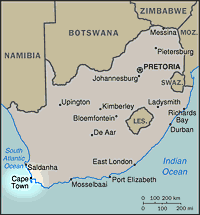
Today, President Clinton attends a bilateral meeting with South AfricanPresident Nelson Mandela. Following the meeting, the Presidents hold ajoint press conference. Later in the afternoon, President Clinton andPresident Mandela tour Robben Island.
Robben Island is one of the best-known and most poignant symbols of theoppression of the apartheid regime. From the 1950s until 1991, the prisonon Robben Island housed black opposition figures, union organizers andmilitant activists. During its years as a political prison under theapartheid regime, Robben Island held approximately 3,000 prisoners.
President Mandela, the prison's most famous inmate, spent 18 years therefor his role as a leader of the anti-apartheid movement. Robben Island hassince been converted into a museum; tens of thousands of South Africans andforeigners visit every year to tour the Island and see Mandela's cell.Former inmates and prison guards act as tour guides.
Lying 13 kilometers off Cape Town, the Dutch named Robben Island after themany seals ('rob') they found there. Fifteenth century Portuguese sailorsand later Dutch and British traders and colonists used the island as anoutpost and prison. Beginning late in the 17th century, the Dutch EastIndia Company regularly imprisoned criminals and political opponents onRobben Island. In the 1800s, it was used as a hospital, an asylum for thementally ill and a place to isolate lepers. In this century, the islandalso served as a military installation.
|

